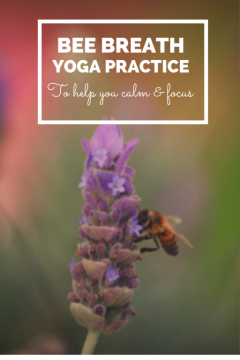
One of my favorite practices for initiating my own meditation practice is Bee Breath, but it has many applications for achieving and sustaining a balanced emotional and mental state. Try this practice, if you or your students and clients suffer from anxiety, ADHD, or OCD. You will find it will cut through the tangle of distracting thoughts. You will feel calm and at ease and be able to focus.
This breathing practice slows down the exhalation and has a calming effect on the entire nervous system. In India, it is often recommended for women in labor.
- Sit in a comfortable position with the spine erect.
- Inhale through the nostrils, drawing the root of the tongue to the back of the throat.
- Slightly tilt the chin and keep the lips sealed.
- On the exhale you will be drawing the back of your tongue to the back of your throat, as though dislodging a popcorn kernel.
- Exhale slowly through the nostrils, making a deep buzzing sound in your throat like a bee. Because the lips are closed, you will not hear the “ZZZ” sound. Instead, you will hear a “swarm” of bees in your throat.
- Start with three rounds on the exhale only.
- Practice this breath no more than 10 times.
This is a wonderful practice to interrupt the negative spiral of thoughts that sometimes accompanies depression and anxiety. It also interrupts the intrusive thoughts associated with obsessive compulsive disorder (OCD).
Teaching Bee Breath
When instructing a client or student that is new to bee breath, use the following script:
- Sit in a comfortable position with the spine erect
- Make the sound of the bee
- Continue making the sound of a bee but close the lips
- Now tuck the chin lightly and begin to feel the vibration in the throat
- Now, draw the back of the tongue to the back of the throat as though you were attempting to get a popcorn kernel husk from the throat
Mudras for the Practice of Bee Breath
You may also use Shanmukhi mudra or a modification to enhance the withdrawal of the senses (pratyahara.)
 Shanmukhi mudra (womb mudra)
Shanmukhi mudra (womb mudra)
Index fingers point to the brow point;
Middle fingers cover the eyelids;
Ring fingers are at the edge of the nostrils, not touching the nostrils;
Little fingers are placed at the edge of the lips,
Thumbs press the outer cartilage near cheekbone into the ear canals.
If your client/student dislikes shanmukhi mudra or suffers from sound sensitivity use one of the following alternatives.
 Helmet mudra
Helmet mudra
This is an alternative mudra that may feel soothing and is appropriate for those few for whom Shanmuki mudra triggers claustrophobia.
- Bring the hands to the top of the head
- Index fingers meet at the hairline
- The rest of the fingers spread along the scalp, touching or reaching toward each other
- Thumbs press the outer cartilage into the ear canals
 You can practice Bee Breath with me on the LifeForce Yoga Chakra Clearing Meditation or at one of the many LifeForce Yoga Events. To find a LifeForce Yoga Practitioner in your area to learn and practice Bee Breath and many other mood management tools from the yoga tradition please click here.
You can practice Bee Breath with me on the LifeForce Yoga Chakra Clearing Meditation or at one of the many LifeForce Yoga Events. To find a LifeForce Yoga Practitioner in your area to learn and practice Bee Breath and many other mood management tools from the yoga tradition please click here.